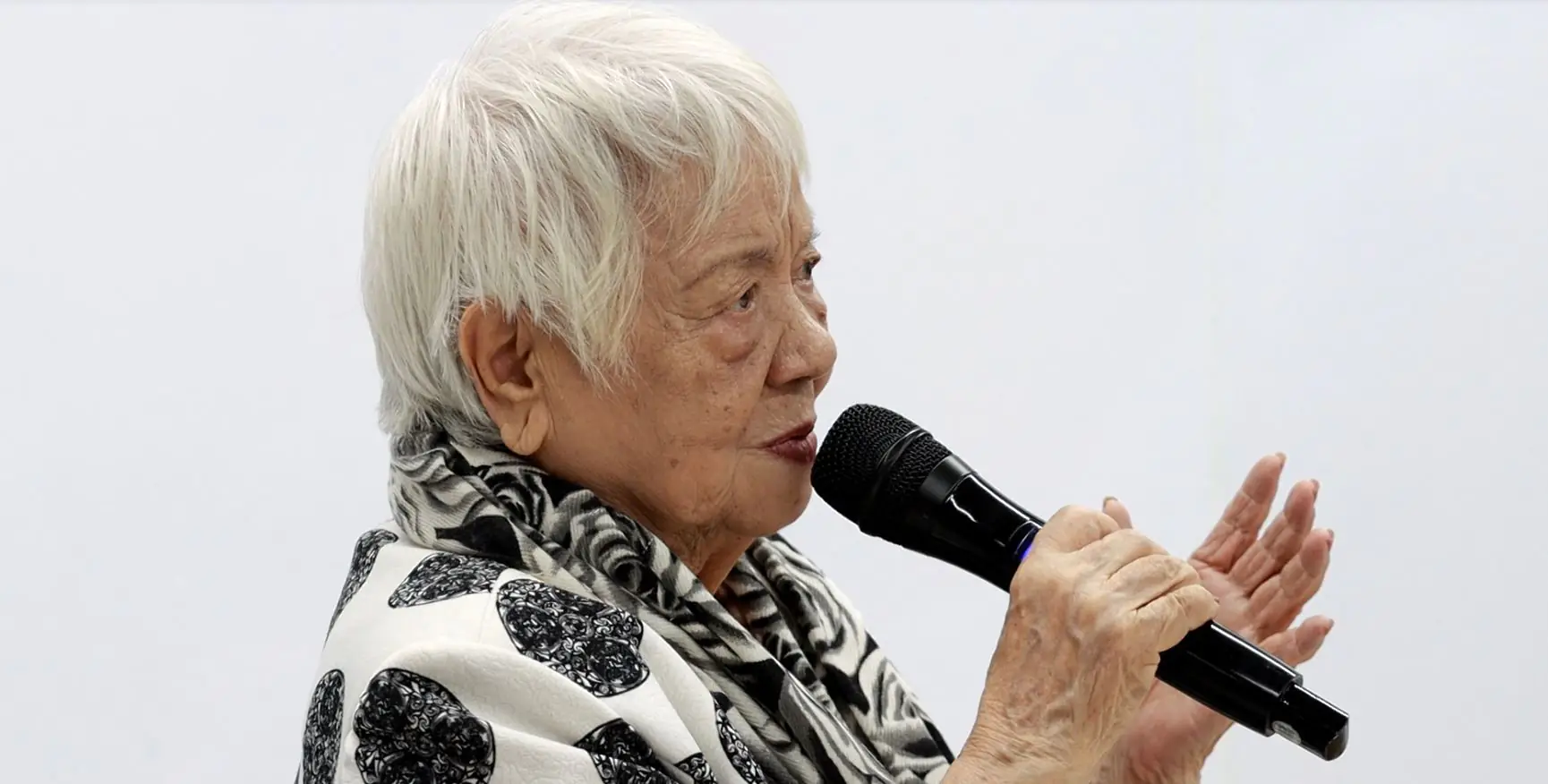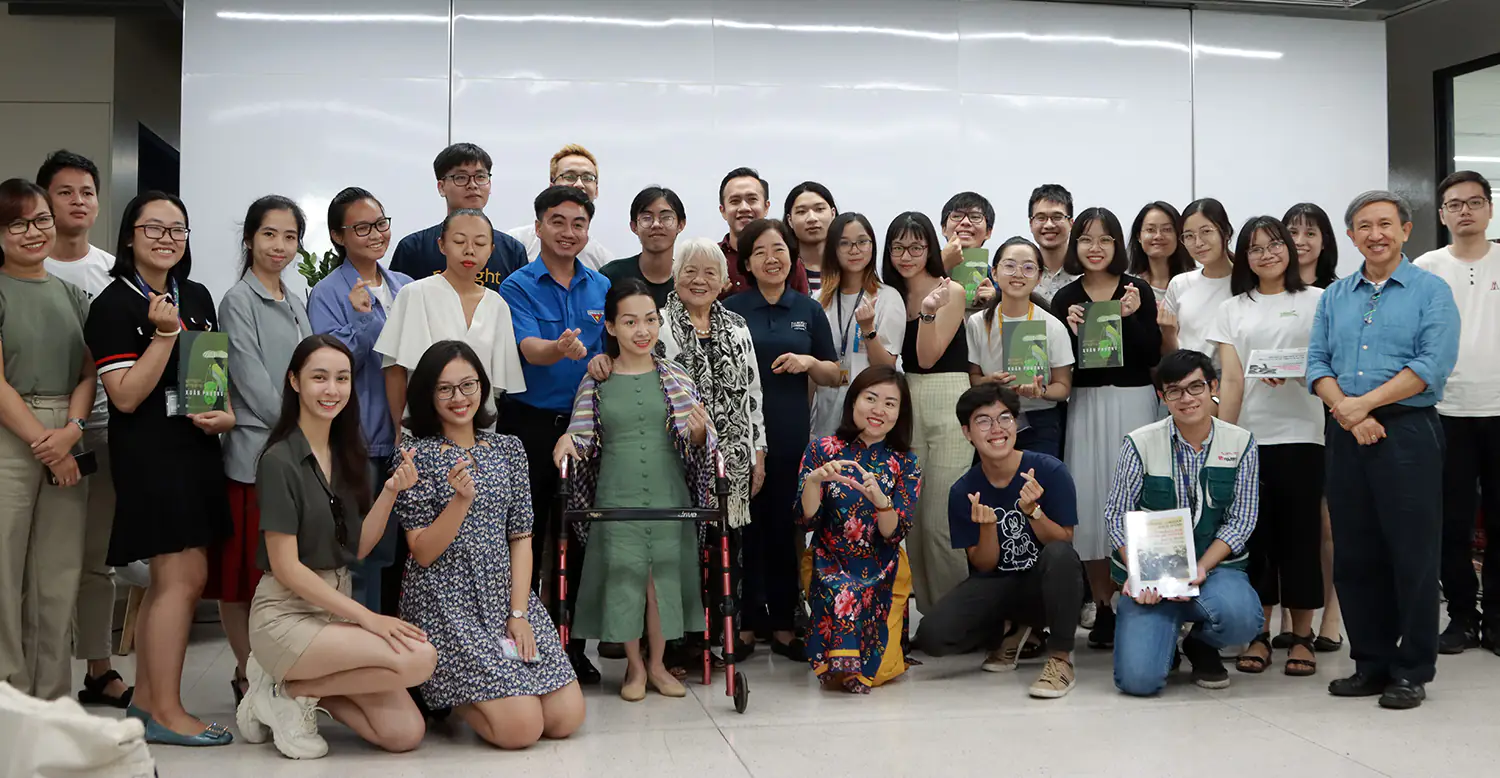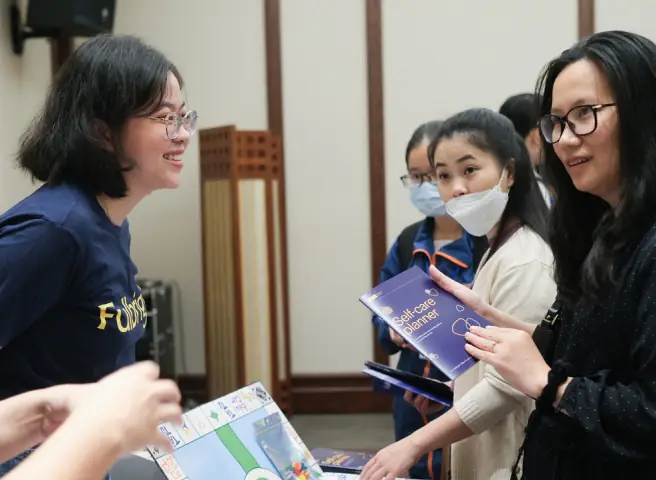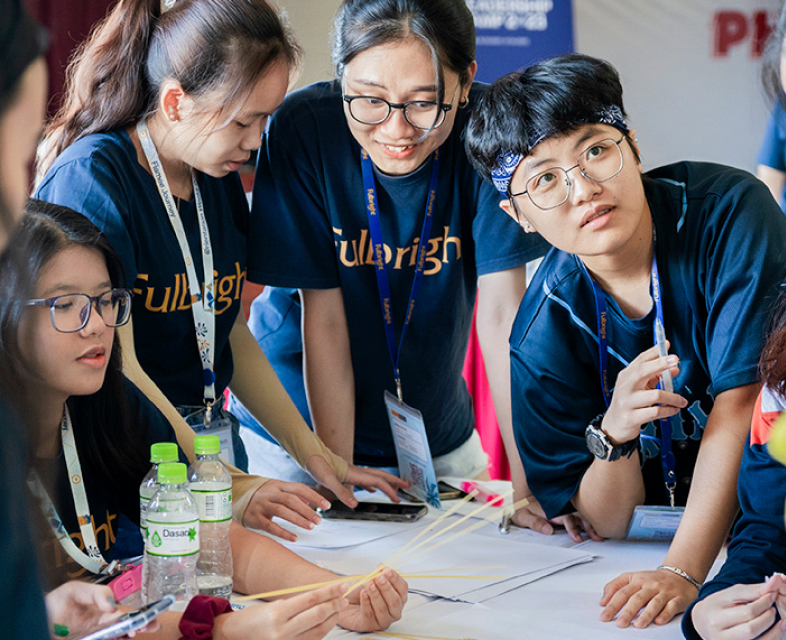
Le 17e Parallel: La Guerre Du Peuple directed by Joris Ivens (a veteran Dutch documentary filmmaker) was introduced in the framework of Vietnamese studies at Fulbright this Spring semester. Director Nguyen Thi Xuan Phuong, a witness, a crew member of the documentary, has come for an open discussion with Fulbright students and the close-knitted community.
The 17th parallel military zone, called for by the Geneva Accords of 1954, is a plenteous topic, reflecting the nation’s history in a crucial period during the war. The background of the film is a nagging reality: after the Geneva Accords (1954), Hien Luong bridge and Ben Hai river (Vinh Thanh commune, Vinh Linh district, Quang Tri) became a provisional military demarcation line at the 17th parallel, dividing the North and the South. Under the Accords, the 17th parallel demilitarized zone was created with international supervision, only to serve a temporary demarcating purpose until the general election in 1956.
Joris Ivens’ cinematography leans towards more of an illustrative approach, portraying a unique angle behind the 17th Parallel with vivid, tormenting, and haunting images. The film screening followed by a talk with Director Nguyen Thi Xuan Phuong was an occlusive experience, allowing students to enter a multi-dimensional Vietnamese studies realm, where they can submerge their knowledge learned from academic lectures into contextual stories and truly expound to apprehend the nation’s historical/cultural roots.
Behind the battlefield
Director Xuan Phuong, even at the age of 90, still can recall distinctly the stifling feeling of the first night in the underground labyrinth of Vinh Linh (Quang Tri). Entrusted by President Ho Chi Minh, she was to escort the film crew, as a doctor and an interpreter. Accompanying Director Joris Ivens and his partner, Mrs. Marceline Loridan Ivens (who was in charge of all sound recordings of the documentaries), were 7 cameramen from 4 Vietnamese studios. They came to the 17th parallel demilitarized zone at Vinh Linh, Quang Tri at the most treacherous moment of the battlefield, a May day in 1967.

Fulbright students talking with Director Nguyen Thi Xuan Phuong
The journey from Ha Noi to Vinh Linh riding on military jeeps was the first drill to prep for the harrowing warzone: the real distance was only 600 kilometers, but it took them 28 days to finally arrive because the bombing was de trop. They got injured and faced death many times, the jeeps were completely ravaged. Their underground “home” was just finished right before they arrived. Mrs. Phuong remembers “groping on to nothing trying to find her way down the tunnel one step at a time, hands pricked with resin from the freshly cut tree roots” in the dark, stuffy blackness of the tunnel.
But, Joris Ivens did not open Le 17e Parallel: La Guerre Du Peuple with such baffling experience.
The first image was the North’s flying red flag with a gold star, bomb-ripped, almost seemed like it was covering the South, symbolized a hope for reuniting the two parts of the nation. The crew called this Hien Luong flag. Just this opening scene alone took an unimaginable amount of courage and fierceness: the cameramen had to climb up the flagpole amidst heavy bombarding to get that one shot. Closing the documentary was a commoner’s classroom in a tiny hideaway tunnel, children were reciting English words to use in case of confronting soldiers as bombs were being dropped up above their heads. The film revealed slices of the people’s lives behind the battlefield, recounted their daily activities of working under the frantic firebombs, unveiling the children’s “game” of fighting and capturing drills, and even some traumatic scenes of deaths.
The unarranged camera angles exposed an ordinary and chilling reality. Joris Ivens intentionally refrained from displaying excruciating images, only showing some battle scenes strategically to highlight the civil lives during warfare.
Included in the film were vibrant dialogues and lively sounds recorded by Marceline Loridan. They were the indispensable elements to complement the raw images captured by Vietnamese cinematographers. Combining audio and visuals together, the documentary illustrated an original description of the lives at Vinh Linh. Many lines from those dialogues made a cruel impression on the filmmakers, such as “even if we have to sacrifice ourselves, we have to protect our crops”.
“Joris Ivens did not name the documentary the Vietnam war or the American war, but he called it the people’s war. We made the film to prove that the people’s war is an invincible war,” Mrs. Phuong emphasized.

In the two months of filming, the crew witnessed life and death, humanity, and love at the hostile warzone of Vinh Linh. Mrs. Nguyen Thi Xuan Phuong wholeheartedly keeps the memories of the young love story between a cameraman and a frontline volunteer. Their meeting was untimely, so despite their affection for each other, the girl decided to wait until the nation is unified. Tragedy struck when the man unintentionally caught on his camera his beloved girl lying under the remnants after a bombing attack. Their promise awaits unfulfilled.
On the other hand, one can also find hope in the cruel reality. Doctor Xuan Phuong experienced levitating happiness when she heard the cry of a father and a newborn child that she has helped deliver in the deep, dark tunnel. The trench was pitch-black that no one could see a thing, but it also made the sounds become all the more precious. The screams of the mother, the directions of the doctor, the cry of the father and the baby, all harmonized together to draw a vivid image of the hardship, which can move anyone to tears. The diring circumstances, lacking and fragile in many ways made birthing so sacred, like a spiritual medicine to heal pain and help people overcome fears.
Recalling that fateful night when a woman in labor was in critical condition, Dr. Phuong still reminisces chilling feels. Everyone including Mr. and Mrs. Ivens stayed up all night worrying about the mother and her child. When the news broke that the baby was born safely, Joris told Phuong that they should be grateful to have a job that allowed them to witness the fine line between life and death. It was their blessing to see life in the underground labyrinth even when death was always nearby.
Cinematography and the revolutionary inspiration
Filmmaking is not just a profession. It also fuels filmmakers with revolutionary spirits.
After two months of battling adversity in Vinh Linh with the film crew, Dr. Nguyen Thi Xuan Phuong returned to her normal life at her modern, fully equipped clinic in Ha Noi. Coming back to her old job of providing healthcare for diplomatic guests, she felt unfulfilled. She missed the days living under bombs and bullets in Vinh Linh, sleeping in the dark and stuffy hideaway tunnel. Because that was where she found a sense of attachment, humanity, love, and the willingness to sacrifice for one another, amongst the crew and the people in Vinh Linh. She recalled Mr. Ivens’ advice before they parted.

Dr. Vu Minh Hoang (Fulbright’s Faculty) chatting with Director Nguyen Thi Xuan Phuong
“I remember he said that a doctor or an interpreter were both necessary, but to find a female war filmmaker in Vietnam was not easy. So he wanted me to boldly make a revolutionary leap for myself, to do complete the mission that the country desperately needed.”Hence, at the age of 37, when she was settled down with a happy family, had three kids and well into a good track of her career, she decided to leave her comfort zone to take the first steps of becoming a war filmmaker, a director, and the first female war correspondent in Vietnam. She reported on many fronts, from the Southern battlefield to the Southwestern and Cambodian border.
“Having gone into a place where 90% of the time we were surrounded by death, after living through the harsh days in Vinh Linh, witnessing the people’s strong will and loving spirit, I was struck. We only live once, we must try to do what is necessary and what is right. Vinh Linh has changed my perspective on life, the humane self, the way we view one another, and above all, encouraged me to voluntarily become a war reporter, contributing my all until the nation reunited at peace.” – Director Nguyen Thi Xuan Phuong shared.
Mrs. Phuong’s first filmmaking teacher, Mr. Joris Ivens, was a veteran documentary filmmaker with a special destine who chose to tell the stories of revolutionary struggles across the globe. His life partner, Mrs. Marceline Loridan was a Jewish survivor of the Nazis Auschwitz concentration camp. She was fortunate enough to be liberated by the Red Army just five days before their scheduled incineration. Together, Mr. and Mrs. Ivens chose a career in filmmaking, not only as a job but also as their inspiring grand mission and passion.

Director Nguyen Thi Xuan Phuong and Fulbright’s students and faculty after the screening event
Director Xuan Phuong recounted a story of when she visited France to attend Mr. Joris Ivens’ funeral. Marceline greeted her and told her about an American film distributor who came to Paris to see the screening of Le 17e Parallel: La Guerre Du Peuple. The documentary was only screened at a small yet prestigious cinema in Paris then. After the screening, the American film distributor said: “Mr. Ivens, I cannot recommend releasing this documentary on television in the United States because if us Americans watch this film, we would understand that America has lost greatly in this war.”
Along with the storage in a French museum, Le 17e Parallel: La Guerre Du Peuple was later given back to Vietnam by the Dutch Government. This is one in a series of four documentaries that Joris Ivens had directed, gifted back to the Vietnamese Film Institute by the Joris Ivens Europe Institute. Besides the documentaries, Joris Ivens also left 2000 pages of written documents, 140 photos and posters that he cherished throughout his career as proof of his special love for Vietnam.
Xuân Linh







